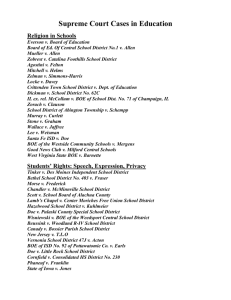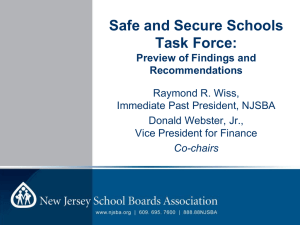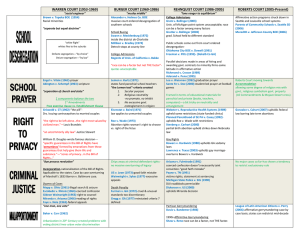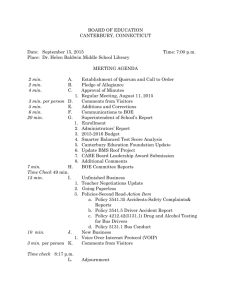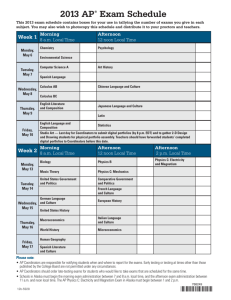Document 10525377
advertisement
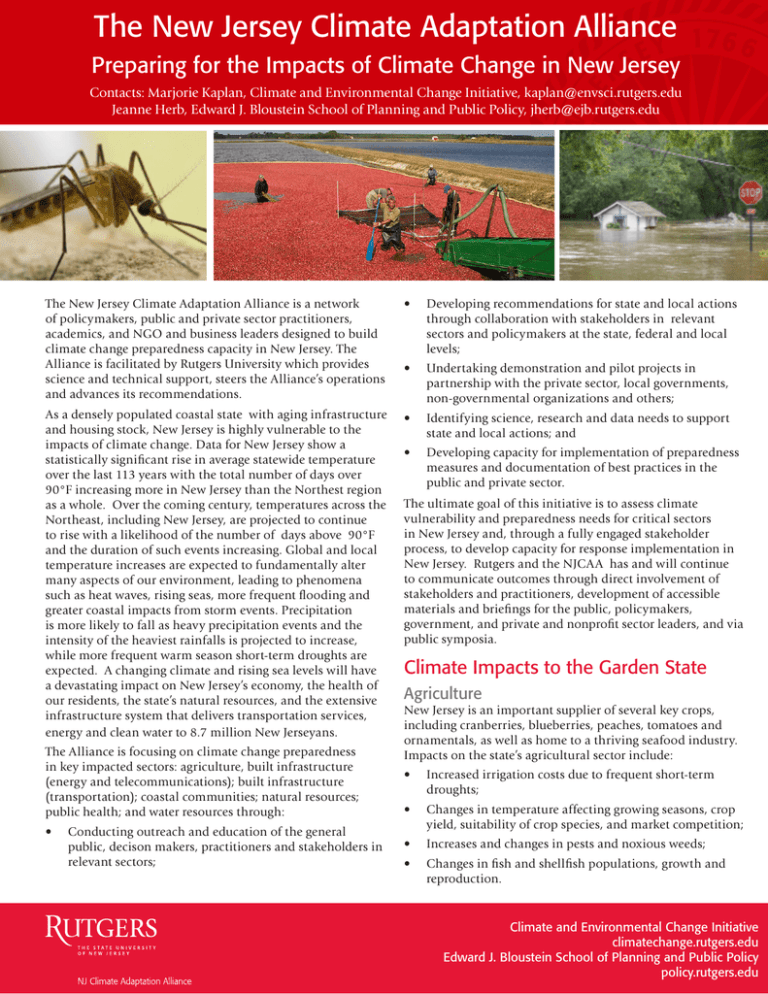
The New Jersey Climate Adaptation Alliance Preparing for the Impacts of Climate Change in New Jersey $POUBDUT.BSKPSJF,BQMBO$MJNBUFBOE&OWJSPONFOUBM$IBOHF*OJUJBUJWFLBQMBO!FOWTDJSVUHFSTFEV +FBOOF)FSC&EXBSE+#MPVTUFJO4DIPPMPG1MBOOJOHBOE1VCMJD1PMJDZKIFSC!FKCSVUHFSTFEV The New Jersey Climate Adaptation Alliance is a network of policymakers, public and private sector practitioners, academics, and NGO and business leaders designed to build climate change preparedness capacity in New Jersey. The Alliance is facilitated by Rutgers University which provides science and technical support, steers the Alliance’s operations and advances its recommendations. t %FWFMPQJOHSFDPNNFOEBUJPOTGPSTUBUFBOEMPDBMBDUJPOT through collaboration with stakeholders in relevant sectors and policymakers at the state, federal and local levels; t 6OEFSUBLJOHEFNPOTUSBUJPOBOEQJMPUQSPKFDUTJO partnership with the private sector, local governments, non-governmental organizations and others; As a densely populated coastal state with aging infrastructure and housing stock, New Jersey is highly vulnerable to the impacts of climate change. Data for New Jersey show a statistically significant rise in average statewide temperature over the last 113 years with the total number of days over 90°F increasing more in New Jersey than the Northest region as a whole. Over the coming century, temperatures across the Northeast, including New Jersey, are projected to continue to rise with a likelihood of the number of days above 90°F and the duration of such events increasing. Global and local temperature increases are expected to fundamentally alter many aspects of our environment, leading to phenomena such as heat waves, rising seas, more frequent flooding and greater coastal impacts from storm events. Precipitation is more likely to fall as heavy precipitation events and the intensity of the heaviest rainfalls is projected to increase, while more frequent warm season short-term droughts are expected. A changing climate and rising sea levels will have a devastating impact on New Jersey’s economy, the health of our residents, the state’s natural resources, and the extensive infrastructure system that delivers transportation services, energy and clean water to 8.7 million New Jerseyans. t *EFOUJGZJOHTDJFODFSFTFBSDIBOEEBUBOFFETUPTVQQPSU state and local actions; and t %FWFMPQJOHDBQBDJUZGPSJNQMFNFOUBUJPOPGQSFQBSFEOFTT measures and documentation of best practices in the public and private sector. The Alliance is focusing on climate change preparedness in key impacted sectors: agriculture, built infrastructure (energy and telecommunications); built infrastructure (transportation); coastal communities; natural resources; public health; and water resources through: t Conducting outreach and education of the general public, decison makers, practitioners and stakeholders in relevant sectors; The ultimate goal of this initiative is to assess climate vulnerability and preparedness needs for critical sectors in New Jersey and, through a fully engaged stakeholder process, to develop capacity for response implementation in New Jersey. Rutgers and the NJCAA has and will continue to communicate outcomes through direct involvement of stakeholders and practitioners, development of accessible materials and briefings for the public, policymakers, government, and private and nonprofit sector leaders, and via public symposia. Climate Impacts to the Garden State Agriculture New Jersey is an important supplier of several key crops, including cranberries, blueberries, peaches, tomatoes and ornamentals, as well as home to a thriving seafood industry. *NQBDUTPOUIFTUBUFTBHSJDVMUVSBMTFDUPSJODMVEF t *ODSFBTFEJSSJHBUJPODPTUTEVFUPGSFRVFOUTIPSUUFSN droughts; t $IBOHFTJOUFNQFSBUVSFBGGFDUJOHHSPXJOHTFBTPOTDSPQ yield, suitability of crop species, and market competition; t *ODSFBTFTBOEDIBOHFTJOQFTUTBOEOPYJPVTXFFET t $IBOHFTJOmTIBOETIFMMmTIQPQVMBUJPOTHSPXUIBOE reproduction. Climate and Environmental Change Initiative climatechange.rutgers.edu Edward J. Bloustein School of Planning and Public Policy policy.rutgers.edu Built Infrastructure *ODPSQPSBUJOHDMJNBUFJNQBDUTJOUPMPOHUFSNQMBOOJOH design, maintenance, and protection of the state’s built infrastructure is critical to protect public health and the TUBUFTFDPOPNZ*NQBDUTNBZJODMVEFEBNBHFUP t *ODSFBTFEBNCJFOUUFNQFSBUVSFTBOEXBUFSDIFNJTUSZ changes that will affect ecosystem function and biodiversity; t 3FEVDFEBCJMJUZPGOBUVSBMTZTUFNTUPQSPWJEFTPDJFUBM services, including flood control, clean and plentiful water, fisheries and ecotourism. t 5SBOTQPSUBUJPOJOGSBTUSVDUVSFBGGFDUJOHQBTTFOHFSBOE commercial travel; t 5IFGVODUJPOBMJUZPGXBUFSCPSOFTIJQQJOHGBDJMJUJFTBOE ports operations; t &OFSHZJOGSBTUSVDUVSFTVDIBTUSBOTNJTTJPOMJOFT substations and power plants; t *ODSFBTFEJODJEFODFPGDBSEJPWBTDVMBSBOESFTQJSBUPSZ diseases due to worsening air quality; t )PVTJOHJODPBTUBMBSFBTBOEVSCBOBOETVCVSCBO waterfront communities; and t t %SJOLJOHXBUFSBOEXBTUFXBUFSJOGSBTUSVDUVSF *ODSFBTFTJOIFBUFYIBVTUJPOIFBUTUSPLFBOE exacerbation of chronic health conditions (respiratory and cardiovascluar disease) from extreme heat events; t *ODSFBTFTJOWFDUPSCPSOFBOE[PPOPUJDEJTFBTFTBOE diseases historically confined to warmer climates; t 4USBJOPOQVCMJDIFBMUIJOGSBTUSVDUVSFBUBMMMFWFMTJO response to chronic and acute health impacts. Coastal Communities Hurricane Sandy demonstrated the devastating impact storms and flooding can have on New Jersey’s coastal communities. The effects of climate change are anticipated to affect communities along the Atlantic coast, the Delaware Bayshore, and tidal waterways with impacts that include: t *ODSFBTFEnPPEJOHBOEFSPTJPOJODPBTUBMBSFBT damaging coastal homes, businesses, infrastructure, beaches and tidal wetlands; t 3JTLTUPIVNBOMJGFBOEQVCMJDIFBMUIGSPNJODSFBTFE precipitation and flooding events coupled with rising sea level; t %JNJOVUJPOPGUIFPWFSBMMWJUBMJUZPGUIFTUBUFTDSJUJDBM shore tourism industry. Public Health Anticipated impacts include: Water Resources *ODSFBTFEGSFRVFODZPGESPVHIUTBOENPSFQSFDJQJUBUJPO occurring earlier in the year with less water available during the summer months, have implications for both water supply and water quality. Sea level rise and its ability to influence saltwater intrusion in groundwater systems is also a clear risk. Water resources concerns include: t $IBOHFTJOESJOLJOHXBUFSTVQQMZBOERVBMJUZBTBSFTVMU of drought, salt water intrusion and changes in rainfall intensity; t 8BUFSTIPSUBHFTXJUITFWFSFDPOTFRVFODFTGPS agriculture, businesses, utilities, hospitals, nursing homes and the public; t *ODSFBTFEnPPEJOHJODPNNVOJUJFTBGGFDUJOHSFTJEFOUT infrastructure, businesses, and commerce. Learn more about the New Jersey Climate Adaptation Alliance Natural Resources New Jersey’s ecological resources include habitat for rare plant and animal species, coastal and freshwater wetlands, prime nesting habitats for migratory birds, 127 miles of Atlantic coastline and over a thousand miles of tidal waterways, and undisturbed diverse forests. Anticipated impacts include: t *ODSFBTFTJOTFBMFWFMUIBUXJMMBGGFDUmTIBOEXJMEMJGF habitats, including tidal nurseries and nesting habitats for shorebirds, marine life and migratory species; climatechange.rutgers.edu/njadapt.html Learn more about Climate Impacts to NJ climatechange.rutgers.edu/climateimpacts.html Photo Credits: p.1 (l): iStockphoto.com (c): Jack Rabin (r): Anthony Broccoli p. 2 Norbert Psuty © 2013 Rutgers, The State University of New Jersey. All rights reserved. Climate and Environmental Change Initiative climatechange.rutgers.edu Edward J. Bloustein School of Planning and Public Policy policy.rutgers.edu
